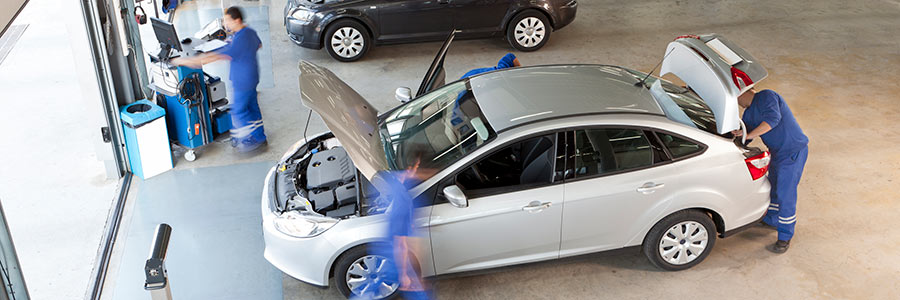
TEAM INCENTIVES: HOW TO KEEP EMPLOYEES ENGAGED, OPTIMISTIC
Over the last 15 years, since we started helping shop owners in 1999, I’m pretty sure I’ve seen every pay plan known to man. I’m also pretty sure that I’ve heard every possible variation of the same question: “How can I pay my team in a way that motivates them without eating all of my profits?”
So what makes a good pay plan? I can’t give you specifics in this article — pay plans should be based on your specific shop and your unique employees. But I can cover what makes an incentive-based pay plan work, and I can absolutely teach why they’re critical for growing your shop.
(A brief note before we dig in: the other thing that is unique to your situation is the law where you live. Not all states allow truly incentive-based pay plans — I’m looking at you, California — so please consult with a labor attorney before changing the way your shop pays.)
Finding the Right Motivation
One of the most important principles that I go by when developing pay plans is: keep it simple. A pay plan should be understandable, first and foremost.
Technicians are detail oriented — it’s what makes them good technicians. Which means that if you institute a pay plan, they’re going to keep track of their progress toward goals. I’ve never known a tech who waited until the end of a pay period to figure out how much money he’s going to take home. They all keep track, maybe not all daily, but all of them do.
The Carrot, Not the Stick
The second checkbox to tick when you’re considering pay plans is “achievable.” If your team’s benchmarks are so high and require so much growth that they’re months away from actually increasing their pay, it’s actually a disincentive. In other words, pay plans shouldn’t be about punishing your employees.
Consider this situation: your service advisor misses his goal. His head goes in the toilet, and he loses his confidence and motivation. It could take weeks to turn his head around! You’ll spend weeks trying to dig him out of that hole. Meanwhile, his performance drops (as a self-fulfilling prophecy), average RO drops and total shop sales drop — all of which drag him down farther, burying him deeper in the mud you’re trying to pull him out of.
That’s why achievable goals are so important.
This doesn’t mean that the goals should be so easy that your employee reaches it every time. That’s called a salary increase, not an incentive-based pay plan.
Incentives Vs. Hourly Rate
If the first thing you think of when I talk about incentive-based pay plans is how hard a sell it will be to your techs, you’re not alone. At first glance, telling your tech that they’ll be paid for the hours they bill, instead of the hours they work, seems like a good way to lose a good tech.
And if you don’t believe in the pay plan, that’s how they’ll see it. Great techs have a tendency to be prima donnas, and switching them off of hourly pay without showing them the benefits can be a huge hit to their ego.
But that’s the beauty of the incentive-based pay plan.
But give them a way to blow past what they could make at an hourly rate? That’s where the best techs will jump at the chance to take 50 solid billed hours at a slightly lower hourly rate, over the hourly rate.
In other words, when you’re talking to your techs about their incentive-based pay plan, the challenge isn’t how much they make per hour, but rather, “the hours are here — how many can you bill?”
Winning Over Resistance
Of course, I’ve been around the block enough to know that this isn’t the end of resistance to incentive-based pay plans. More billable hours leading to a bigger paycheck all starts with the technician doing the kind of thorough inspections and write-ups that lead to more billable hours. But a lot of techs kick back against the idea of doing thorough inspections and write-ups because they take time — time they’re not paid for.
Some of them really have a mental issue with it.
In my shop — and this is what we teach our clients, too — your goal should be to challenge them: trust us for two weeks and see what happens.
Not to mention the fact that inspections fill the pipeline! Work that isn’t sold today will come in tomorrow, next week or next month. It keeps the shop busy, preventing slow days.
Even though inspections seem like non-productive time, it’s the most productive time a technician can spend — if they can get it through their head.
By the end of those two weeks, we’ve proven to the resistors that it’s going to make them more money to follow our system and perform thorough inspections. Every time.
No matter how good a job your employees are doing now, they can do better.
Techs can do better inspections and write-ups, and service writers can refer more work to the technicians than they’re doing now.
Without a measurement system in place, it can be a pain in the butt to track. (It’s one of the reasons I created the measurement system called the RPM ToolKit.) But for the small amount of time invested in tracking the benchmarks in incentive-based pay plans, your shop will reap dividends: in the training your employees do, in the accountability your employees are held to, and how everyone is on the same page in terms of reaching shop goals.
View “Team Incentives: How To Keep Employees Engaged, Optimistic” by David Rogers
You can also download a PDF version of this article here.

